Table of Contents
PREFACE
Chapter One: Aboriginal Rights
1.1 INTRODUCTION
1.2 SECTION 35
1.2.1 History
1.2.2 Subsection 35(1)
1.2.3 Subsection 35(2) – Aboriginal Peoples of Canada
1.2.4 Subsection 35(3) – Modern Treaty Rights and Land Claims Agreements
1.3 ABORIGINAL RIGHTS
1.3.1 Definition
1.3.2 Establishing an Aboriginal Right – The Van der Peet Test
1.3.3 Proof and Evidentiary Issues
1.3.4 Extinguishment
1.3.5 Infringement
– 1.3.5.2 Unreasonable Limitation
– 1.3.5.3 Undue Hardship
– 1.3.5.4 Preferred Means
1.3.6 Justification of Infringement
– 1.3.6.2 Compelling and Substantial Objective
– 1.3.6.3 Honour of the Crown
1.4 SECTION 25, CANADIAN CHARTER OF RIGHTS AND FREEDOMS
1.5 INDIVIDUAL AND COLLECTIVE RIGHTS
1.6 SELF GOVERNMENT
– 1.6.1.1 R. v. Pamajewon
– 1.6.1.2 Campbell v. B.C.
– 1.6.1.3 Mitchell v. Canada (Min. of National Revenue)
1.6.2 Implementing Self-Government
– 1.6.2.1 Dogrib Treaty 11 Council
– 1.6.2.2 Mohawks of Kanesatake
– 1.6.2.3 Sechelt Indian Band Self-Government Act
– 1.6.2.4 Cree-Naskapi (of Quebec) Act
– 1.6.2.5 Yukon Territory
– 1.6.2.6 Westbank First Nation Self-Government Act
1.6.3 Indian Act
– 1.6.3.1 Legal Status of Indian Band Councils
1.7 INTERNATIONAL LAW
1.7.1 United Nations Declaration on the Rights of Indigenous Peoples
Chapter Two: Aboriginal Title
2.1 INTRODUCTION
2.2 HISTORICAL ASPECTS OF ABORIGINAL TITLE
2.2.1 Royal Proclamation of 1763
2.2.2 Early United States Case Law
2.2.3 Pre-Delgamuukw Canadian Case Law
2.3 ABORIGINAL TITLE
2.3.
